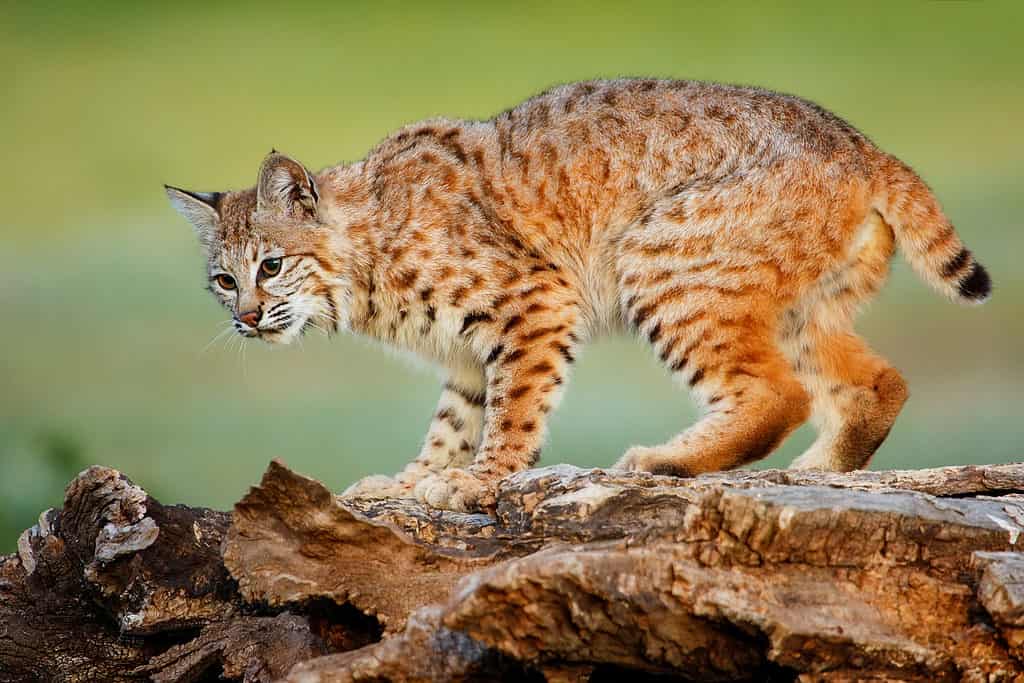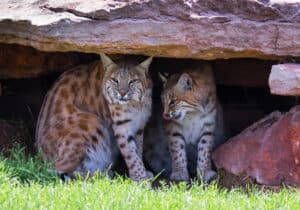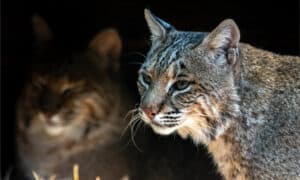Ever seen your pet cat sneaking up on a mouse or even on a toy? This video shows you exactly the same technique but on a much larger scale. It shows the remarkable hunting skills of a bobcat getting closer to a mule deer than you would have thought possible.
Watch the Incredible Video Now!
Bobcat Hunting Skills

Bobcats hunt by stealth with a powerful pounce.
©Don Mammoser/Shutterstock.com
Check out the amazing predatory skills of this bobcat! They are closely related to the Canadian lynx and are medium-sized big cats. They are widely distributed across North America and even though they prefer rocky hillsides they can adapt to a number of different habitats including deserts and suburban areas.
The bobcat’s method of hunting prey is stalking. With incredible stealth, they silently sneak up on unsuspecting animals and then pounce. This uses up far less energy than chasing the prey for miles before eating it!
Their pounce is also incredibly powerful. One of the remarkable features of bobcats is that they are able to tackle animals much bigger than they are – as we see here with this mule deer.
Mule Deer and Their Habitats

Mule deer are prey to a long list of predators – including the bobcat.
Image: Stsvirkun, Shutterstock
©Stsvirkun/Shutterstock.com
Mule deer are found in the western mountains of North America. They are herbivores and ruminants which means that they live off plant material but they have to regurgitate it and ‘chew the cud’ as part of the digestion process. They are known for having exceptionally large ears but that did not help this particular mule deer to hear the approach of the bobcat.
They like to live in woods and scrubland as that provides both food and shelter for them. When it comes to diet, they are not that fussy and eat almost 800 different species of plants and browse many parts including leaves, twigs, nuts, and berries.
These guys have quite a long list of predators that includes coyotes, lynxes, cougars, American black bears, and of course, bobcats. Fit, adult mule deer are not that easy for a predator to catch if they have the opportunity to run. They can reach speeds of 45 mph. In this attack, however, the deer did not get a chance to run away because they didn’t even see the bobcat coming!
How Big Do Bobcats Get?

Bobcats weigh between 15 and 40 pounds with males growing larger than females.
©Geoffrey Kuchera/Shutterstock.com
Bobcats are the smallest member of the lynx family – growing from one – two feet tall at the shoulder. They can weigh up to 40 pounds and are typically 30 – 40 inches long. Male bobcats are bigger than females, are several inches longer and taller, and can weigh 10 pounds more.
As with other wild cats such as cougars, tigers, and jaguars, a bobcat’s size is relative to where it lives. Southern bobcats are smaller than their northern counterparts because the rigors of living in a colder climate require more weight and shorter limbs. A concept in biology called Bergmann’s rule states that animals that live in colder climates tend to be larger and heavier than those close to the equator to better conserve heat. Animals living in warmer climates are longer-limbed and carry less weight.
Regardless of where they live, bobcats are one of the most adaptable cats and one of the most successful hunters. Like all cats – they are capable of bringing down prey twice their size as seen in the video below.
The photo featured at the top of this post is © Victor Arita/Shutterstock.com
Thank you for reading! Have some feedback for us? Contact the AZ Animals editorial team.






